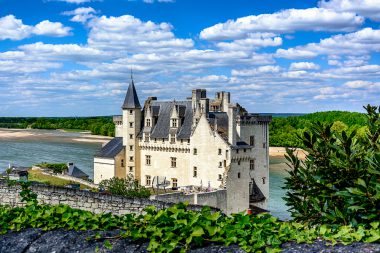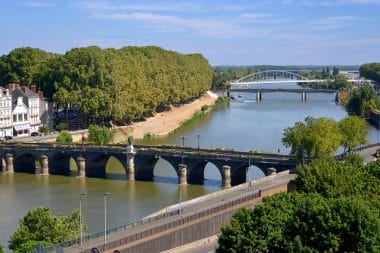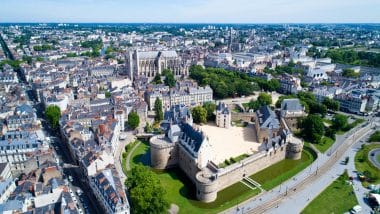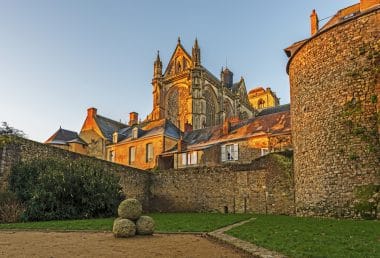West of Tours at the Loire-Anjou-Touraine Nature Park, the Pays de La Loire begins, which stretches along the Loire to the mouth of the river in the Atlantic. The region is one of the most beautiful in Europe and has imposing historic castles and manor houses, lively cities, beautiful nature and many delights to offer.
Along the Loire and its countless tributaries, castles from elegant hunting lodges to royal palaces are lined up like precious stones. In the late Middle Ages and the Renaissance, nobles, princes and kings chose the magnificent valleys of the Loire as their seat for the rural summer palace or permanent residence. The region forms the crown of the almost 1000 kilometers of Loire. Many other castles are located along the river east of the Pays de la Loire.
In addition to the famous castles, it is the pleasurable way of life that makes the region special. The small café offers a magnificent view of the Loire, and the village restaurant serves top wines with culinary delights. Deep forests are the stage for eventful walks, and wine culture characterises wine-growing villages. Salmon are back at home in the clean river. The city of Nantes near the mouth is one of the most beautiful cities in France, which is blessed with magnificent places.
Castles, wine and horses in Anjou
The Pays de la Loire begins in the Anjou wine-growing region, in the heart of which the small old town of Saumur is ruled by the imposing Château of the Dukes of Anjou. Wines from Anjou such as dry white wines, sparkling wines, dry red wines and semi-dry and sweet rosé wines can be tasted in the wine bars and restaurants or in the Maison du Vin next to the tourist office. White limestone villas and half-timbered houses, often decorated with carved figures, stand along the narrow streets.

Typically French comfortably furnished streets prepare a shopping paradise. On the river, the magnificent old town hall watches over order. The local horse culture, still alive today in the “cavalry school” and many riding stables, is cultivated in the horse museum. The Romanesque Notre-Dame-de-Nantilly contains a colourful collection of historical tapestries. 15 kilometres to the east along the Loire at the gates of the city lies the Abbaye Royale de Fontevraud in Fontevraud-l’Abbaye, the largest monastery complex in Europe. It dates back to the 11th century. In Montsoreau, a Renaissance château shines right on the shore. The Château de Montreuil Bellay, 15 km south of Saumur, is now home to a magnificent hotel.
Other castles between Saumur and Angers are Montgeoffroy, Baugé and Boumois. The 48-storey Château Brissac is one of the most impressive castles in the Loire Valley.
Art and wine culture near Angers

In the old Loire town of Angers, the fortress of the château built by Louis IX towers over the city with its 17, sometimes 40-metre-high round towers. A historical carpet collection is on display in the castle. Opposite, La Maison du Vin is happy to introduce you to the culture of regional wines. The walk from the fortress to the central Place du Ralliement, meeting place of public life with restaurants and shops, is not far. On Saturday, a market on the Place Imbach shows all the wealth of the region.
The medieval cathedral with its stained glass is remarkable. In the art museum, housed in a Gothic mansion, works by Claude Monet can also be admired. The oldest hospital building in France now houses a hospital pharmacy from the 17th century. and the Museum of Contemporary Carpet Art. Wine culture is best experienced on hikes and tours along the region’s wine routes. Tastings are offered along the routes to Brissac, Savennières or Chaudefond-sur-Layon, for example. Near Saint-Georges-sur-Loire, the medieval fortifications of Serrant Castle have been converted into an imposing Renaissance castle with an English landscaped park. Serrant Castle is the westernmost of all the Loire castles.
The arts and technology in the world of Nantes

The capital of the Pays de la Loire, Nantes, rests about 60 kilometers before the mouth on the river and on an island in the Loire. The castle of Nantes was once ruled by the powerful dukes. The streets and palaces of the wealthy former port city are reminiscent of this princely terrain.
The mighty cathedral in the city centre seems to be striving for the sky with the arches of its central nave. Nantes was the birthplace of the futuristic visionary Jules Verne, who is still revered in the city today. In his birthplace, a museum tells of his life and works. There is a handwritten index with over 22,000 index cards on scientific topics.
The island in the Loire used to be the port area, which was moved to the mouth of the river. It was there at the port that Jules Verne absorbed his visions and it was there that the Les Machines de l’île project was created in the old port halls. Iron artists produce more than just house-sized elephants, animals and constructions that can be moved through the city with mighty steps. These iron artists have carried the name of Nantes in parades, shows and spectacles around the world.
To the north of the city centre, the Talensac market sells local goods and fresh fish from the coast. South of the city, along the road to Clisson, the noble Muscadet is grown as a grapevine. In Nantes, it can be tasted in the wine shops. Between Nantes and Saint-Nazaire at the mouth, the Loire has been transformed into a 60-kilometre-long art trail. Works by French and international artists line the course of the river. The spectacular installation includes huge sculptures, mechanisms reminiscent of Jules Verne’s machine world, and entire houses. At the Château du Pé, artists’ worlds are presented.
Le Mans in the northeast

Far from the Loire lies the centre of the north-east of the Pays de la Loire and the motorsport centre of Le Mans. For a century, the world has been looking at the 24 Hours of Le Mans once a year. This old town also offers its visitors a wonderfully preserved old town centre. It nestles romantically on the Sarthe and Huisne rivers. In the centre of the old town, the old cathedral of Saint Julien du Mans, half Gothic and Romanesque with its other half, rises into the sky. In the walled Plantagenet district, small streets lined with half-timbered houses invite you to visit the shops and restaurants.
The quarter looks so authentic that it has often served as a backdrop for films. The former royal palace now houses the town hall. In the museum of Tessé you can see paintings by old masters. Roman-era ramparts point the way to blooming parks along the banks of the Sarthe. The Papéa Parc amusement park entertains with natural wonders in the city. Le Mans is a stronghold of French arts and crafts. The shops in the city centre sell the works of art of decorators, carpenters, hatters, potters, glassblowers, leather craftsmen and many others. Workshops can often be visited.


